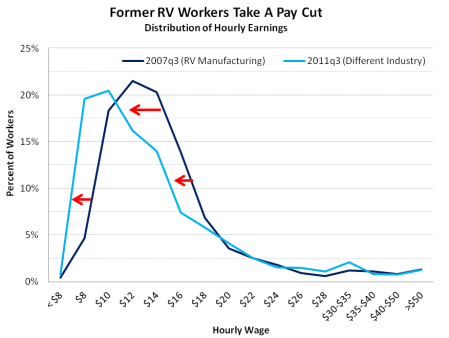![]()

By Josh Lehner
Oregon Office of Economic Analysis Blog..
The following is a brief overview of our office’s new research report: Job Polarization in Oregon. There are many interesting details and nuggets of information in the report, and we highly encourage you to read the whole thing to learn more about how job polarization is impacting the economy.
Click Here to Download the Report
Click Here to Download the Slides
Job polarization — the process of shrinking opportunities for middle-wage jobs, with growth concentrated at the high and low ends of the spectrum — has been shaping the national and local labor market for decades. Since 1980, Oregon has polarized in-line with the average state, however we have done a little bit better in terms of high-wage jobs and lower middle-wage jobs.
In particular, Oregon’s employment growth, and job polarization, has varied considerably by decade. The early 1980s recession, which was very severe locally, impacted growth during that decade, along with the absolute and relative decline of the timber industry in the state in the past 30 years. In the 1990s, growth across the board was strong and Oregon was able to stem the polarization tide. However in the 2000s, middle-wage jobs suffered more than in most other states, with growth heavily concentrated at the high and low ends. As shown previously, employment growth during and after the Great Recession has exacerbated the job polarization trends and nearly all job growth in the past two years has been either high- or low-wage. Please see the report for a more complete discussion on these patterns.
Another important aspect to job polarization in Oregon has been the relative changes in the state’s metropolitan areas compared with the rest of the state. Overall job polarization has been more pronounced in Metro Oregon since 2000. However, nearly all of the high-wage job gains have occurred in Metro Oregon as well. Rural Oregon has seen the loss of many middle-wage jobs over the past 12 years, with employment growth heavily concentrated in low-wage occupations.
What can be done about polarization? The first answer one hears is usually: education, education, education. And that’s right to a certain degree. Overall there is a high correlation between educational attainment and wages, however it is not a perfect one. As seen below there is considerable variation in wages among similar educational groups but also considerable variation in educational attainment among similar wage groups. For example, Teachers and Construction workers get paid approximately the same even though they have substantially different formal education requirements. Additionally, Management — the highest paid — has the lowest educational attainment of the high-wage occupations.
Earning a four year degree is the most likely path to obtaining a job in one of the high paying occupations. However a college degree is not be-all and end-all, particularly for the upper middle-wage jobs. There are also differences between high school degrees and some college education for the lower middle and low-wage jobs. See the report for a discussion on the implications for each type of job, what is the underlying economic driver for these different wage groups, the impacts of job polarization on them and also what it means going forward.
Finally, it is important to remember that these labor market transformations are not costless. The process of job polarization does displace workers. Although the remaining workers are more productive, those most impacted face a tough transition to obtaining another job, particularly if it requires retraining in a new field. A microcosm of the negative side effects of job polarization is the RV industry in Oregon. Based on research by the Oregon Employment Department, and discussed previously on the blog, workers who were able to find another job in Oregon after leaving the RV industry, faced a considerable downward shift in wages. These events, where a worker loses a middle-wage job and replaces it with low-wage work is the bad type of polarization.
Much more information and a more complete discussion of these trends can be found in the report.
Click Here to Download the Report
Click Here to Download the Slides
Disclaimer: Articles featured on Oregon Report are the creation, responsibility and opinion of the authoring individual or organization which is featured at the top of every article.




